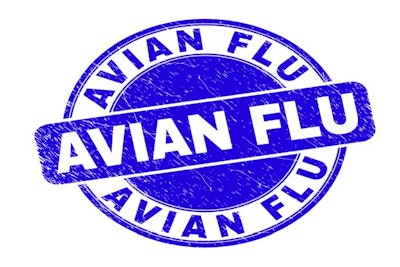
Between December of 2020 and February of 2021, HPAI virus was detected 1,022 times in 25 European countries. These data are reported by the European Food Safety Authority (EFSA) in its latest review of the HPAI situation in Europe.
Of the total, 592 of the cases were in poultry, 421 in wild birds, and nine in captive birds.
With a total of 442 in poultry, France has been the nation worst affected by the disease over this period. With a majority of the outbreaks occurring in a hot-spot in the south-west of the country, foie-gras producers have been bearing the greatest impacts of the infection. Germany has reported 51 detections in poultry over the study period, and Poland 37. There have been confirmed cases in poultry in 14 other states, each with no more than 11.
Over the three-month period, the H5N8 virus variant accounted for 574 of the almost-600 HPAI infections in poultry. In addition, there were two detections of the H5N5 variant, three of H5N1, and 13 in which the virus could not be identified further beyond belonging to the H5 family.
With H5N8 and other HPAI still circulating in wild birds, the threat of HPAI to the European poultry industry is not yet over, according to EFSA.
H5N8 and the threat to human health
Last month, a research institute in Russia registered the first cases of transmission of the avian influenza A(H5N8) virus to people. All seven workers affected have recovered.
To the general population, EFSA assesses the risk of infection related to this virus variant as very low. Even for those occupationally exposed, the level of risk is low. There remains no evidence of human-to-human transmission.
While the emergence of new viral strains is always a possibility, EFSA states that no mutations to date have shown potential to increase the threat to human health.
Avian flu situation in France
Latest information from the agriculture ministry (as of March 1) puts the number of confirmed HPAI outbreaks since November of last year at 481. The number of poultry culled has not been updated since February 12, when it stood at three million — mainly ducks in the southwest of France.
This is 14 more than 10 days previously. All these latest outbreaks were in Gers in southwest France, bringing this department’s total so far to 61. Totals remain the same for other badly affected regions in the area — Landes (341 outbreaks), and Pyrenees-Atlantiques (56). This southwestern region of France accounts for 468 of the country’s total outbreaks.
In addition, there have been 13 HPAI outbreaks in poultry in other regions of France, and HPAI virus has been detected in 14 wild birds at various locations across the country. The most recent was discovered in the Ardennes in the northeast.
New outbreaks in European poultry
Over the past week, two Northern European countries have officially registered new HPAI outbreaks in poultry. In both cases, the presence of the H5N8 virus variant was confirmed.
Estonia’s animal health agency has recorded its first ever outbreak of HPAI in poultry linked to this variant. Affected was a mixed flock of 78 birds in Lääne-Viru, according to the report to the World Organisation for Animal Health (OIE). Majority of the flock died and the rest have been destroyed.
Source of infection is unknown. The location is in the north of the country on the Gulf of Finland, so wild birds could have been the source of the virus.
Also reporting to the OIE a new outbreak in poultry linked to the H5N8 HPAI virus is Sweden. The virus was detected at a broiler farm in Linköping in Ostergötland in the southeast of the country during the third week of February. Around 350 of the 14,500 birds died, and the others have been culled.
Affecting an organic flock, this is the country’s largest outbreak yet, according to the chief vet at the Swedish Board of Agriculture (Jordbruksverket).
Around the same time, an outbreak was confirmed in around 470 pheasants at Skurup in the southern county of Skåne. And on March 1, a poultry flock was hit by the disease in the neighboring county of Halland.
Over the past week, Germany’s national veterinary reference laboratory, Friedrich-Loeffler Institute confirmed seven new cases of HPAI. Affecting hens, chickens and turkeys, four of these cases were in Lower Saxony, two in Mecklenburg-West Pomerania, and one in Bavaria.
At the end of February, the European Reference Lab for avian influenza (IZSVe) held reports of new cases H5N8 HPAI in backyard and hobby flocks in the Czech Republic (3 outbreaks), Denmark (1), Italy (2), and Romania (1).
Since the last outbreak of HPAI in 2015, the U.S. poultry industry has become better prepared to control the disease. However, small flocks still pose a risk.
View our continuing coverage of the global avian influenza situation.

















